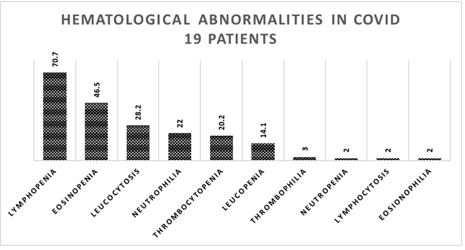Laboratory profile of COVID-19 Patients at the time of admission
Abstract
Background: COVID-19 is a recent pandemic, the complete picture of which is yet to be described. Recent advances in the treatment and improved outcomes have been contributed mainly by knowing the pathological and biochemical status of the patients. Further improvement in understanding this disease at all levels will help in formulating appropriate management plans.
Objective: To describe the various biochemical and haematological parameters of COVID – 19 positive patients at the time of admission to the hospital for treatment. Method: We analysed the biochemical and haematological parameters of 100 COVID patients admitted to our hospital from June 2020 to September 2020.
Results: 60.6% of our subjects were between 40 and 70 Years. 74.7% of the cases were males. Fever and cough were the most frequent complaints and 49. 5% of them had pneumonia at the time of admission. 19% of the patients needed ICU management. The most common haematological abnormality was lymphopenia seen in 79.9% followed by Eosinopenia seen in 46.5%. Reactive lymphocytes were seen in the majority of the patients (84 %). Toxic granules in the neutrophils, fragmented RBCs and significant left shift of neutrophils are found in small proportions. CRP was elevated in 92% of our patients, followed by elevated Ferritin in 78.2%. D-Dimer was elevated in 44.4% of the patients.
Conclusion: The majority of Covid patients at presentation have deranged coagulation and increased D-Dimer. Lymphopenia is the most common haematological abnormality.
Downloads
References
2. Guan WJ, Ni ZY, Hu Y, Liang WH, Ou CQ, He JX, et.al. Clinical characteristics of coronavirus disease 2019 in China. New England journal of medicine. 2020;382(18):1708-20.
3. Lei, S.; Jiang, F.; Su, W.; Chen, C.; Chen, J.; Mei, W, et.al. Clinical characteristics and outcomes of patients undergoing surgeries during the incubation period of COVID-19 infection. EClinicalMedicine 2020, 21. doi: 10.1016/j.eclinm.2020.100331.
4. Xie J, Tong Z, Guan X, Du B, Qiu H. Clinical characteristics of patients who died of coronavirus disease 2019 in China. JAMA network open. 2020 Apr 1;3(4):e205619.
5. Wang Z, Chen X, Lu Y, Chen F, Zhang W. Clinical characteristics and therapeutic procedure for four cases with 2019 novel coronavirus pneumonia receiving combined Chinese and Western medicine treatment. Biosci Trends. 2020 Mar 16;14(1):64-68. doi: 10.5582/bst.2020.01030.
6. Kim ES, Chin BS, Kang CK, Kim NJ, Kang YM, Choi JP, et.al. Korea National Committee for Clinical Management of COVID-19. Clinical Course and Outcomes of Patients with Severe Acute Respiratory Syndrome Coronavirus 2 Infection: a Preliminary Report of the First 28 Patients from the Korean Cohort Study on COVID-19. J Korean Med Sci. 2020 Apr 6;35(13):e142. doi: 10.3346/jkms.2020.35.e142.
7. Tu H, Tu S, Gao S, Shao A, Sheng J. Current epidemiological and clinical features of COVID-19; a global perspective from China. Journal of Infection. 2020;1;81(1):1-9.
8. Shi F, Yu Q, Huang W, Tan C. 2019 novel coronavirus (COVID-19) pneumonia with hemoptysis as the initial symptom: CT and clinical features. Korean journal of radiology. 2020;21(5):537.
9. Qian GQ, Yang NB, Ding F, Ma AH, Wang ZY, Shen YF, et.al.. Epidemiologic and clinical characteristics of 91 hospitalized patients with COVID-19 in Zhejiang, China: a retrospective, multi-centre case series. QJM: An International Journal of Medicine. 2020 1;113(7):474-81.
10. Xu XW, Wu XX, Jiang XG, Xu KJ, Ying LJ, Ma CL, et.al. Clinical findings in a group of patients infected with the 2019 novel coronavirus (SARS-Cov-2) outside of Wuhan, China: retrospective case series. BMJ.2020. doi: 10.1136/bmj.m606.
11. Mi B, Chen L, Xiong Y, Xue H, Zhou W, Liu G. Characteristics and Early Prognosis of COVID-19 Infection in Fracture Patients. J Bone Joint Surg Am. 2020;102(9):750-758. doi: 10.2106/JBJS.20.00390.
12. Wu J, Liu J, Zhao X, Liu C, Wang W, Wang D, et.al. Clinical characteristics of imported cases of coronavirus disease 2019 (COVID-19) in Jiangsu Province: a multicenter descriptive study. Clinical Infectious Diseases. 2020 ;71(15):706-12.
13. Huang C, Wang Y, Li X, Ren L, Zhao J, Hu Y, et.al. Clinical features of patients infected with 2019 novel coronavirus in Wuhan, China. The lancet. 2020;395(10223):497-506.
14. Wang D, Hu B, Hu C, Zhu F, Liu X, Zhang J et.al. Clinical characteristics of 138 hospitalized patients with 2019 novel coronavirus–infected pneumonia in Wuhan, China. JAMA. 2020;323(11):1061-69.
15. Baj J, Karakuła-Juchnowicz H, Teresiński G, Buszewicz G, Ciesielka M, Sitarz E, et.al. COVID-19: specific and non-specific clinical manifestations and symptoms: the current state of knowledge. Journal of clinical medicine. 2020;9(6):1753.
16. Mehta P, McAuley DF, Brown M, Sanchez E, Tattersall RS, Manson JJ. COVID-19: consider cytokine storm syndromes and immunosuppression. The lancet. 2020;395(10229):1033-34.
17. COVID-19 Dashboard by the Center for Systems Science and Engineering (CSSE) at Johns Hopkins University (JHU)". ArcGIS. Johns Hopkins University. Retrieved 22 September 2020. Available at:https://coronavirus.jhu.edu/map.html
18. Jin JM, Bai P, He W, Wu F, Liu XF, Han DM, et.al. Gender differences in patients with COVID-19: focus on severity and mortality. Frontiers in public health. 2020;8:152.
19. Report of the WHO-China Joint Mission on Coronavirus Disease 2019 (COVID-19). Available at:https://www.who.int/publications/i/item/report-of-the-who-china-joint-mission-on-coronavirus-disease-2019-(covid-19)
20. Klok FA, Kruip MJ, Van der Meer NJ, Arbous MS, Gommers DA, Kant KM, et.al. Incidence of thrombotic complications in critically ill ICU patients with COVID-19. Thrombosis research. 2020;191:145-47.
21. Chong VC, Lim KG, Fan BE, Chan SS, Ong KH, Kuperan P. Reactive lymphocytes in patients with Covid‐19. British journal of haematology. 2020;189(5):844.
22. Singh A, Sood N, Narang V, Goyal A. Morphology of COVID-19–affected cells in peripheral blood film. BMJ Case Reports CP. 2020;13(5):e236117.
23. Tan L, Wang Q, Zhang D, Ding J, Huang Q, Tang YQ, Wang Q, Miao H. Lymphopenia predicts disease severity of COVID-19: a descriptive and predictive study. Signal transduction and targeted therapy. 2020;5(1):1-3.

Copyright (c) 2022 Author (s). Published by Siddharth Health Research and Social Welfare Society

This work is licensed under a Creative Commons Attribution 4.0 International License.


 OAI - Open Archives Initiative
OAI - Open Archives Initiative


